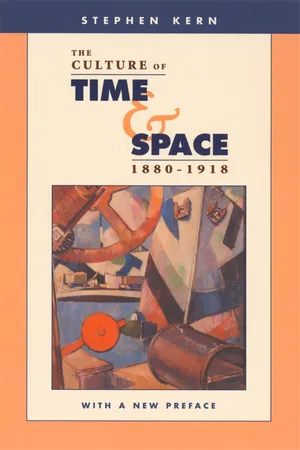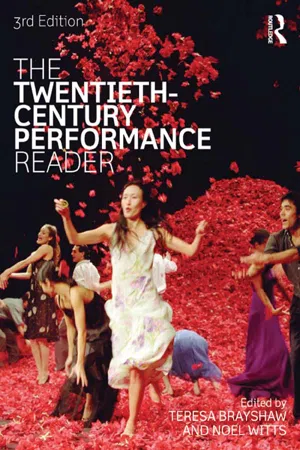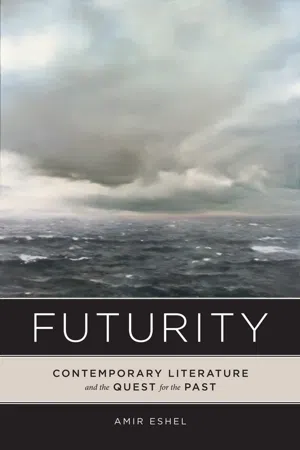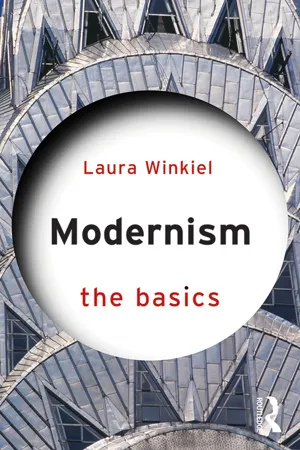Futurism
Futurism was an early 20th-century artistic and literary movement that emphasized the dynamism, speed, and energy of modern life. It rejected traditional forms and embraced technology, urbanism, and the industrial age. Futurist literature often featured unconventional typography, fragmented syntax, and a focus on the machine age, reflecting the movement's celebration of progress and innovation.
7 Key excerpts on "Futurism"
- eBook - ePub
The Culture of Time and Space, 1880–1918
With a New Preface
- Stephen Kern(Author)
- 2003(Publication Date)
- Harvard University Press(Publisher)
...Still others saw mixtures of progress and degeneration, islands of carefree pleasure and oppressive technocracies. The Futurists were not troubled by any ambivalence. They created a kind of science fiction of their own out of the latest of everything in artistic works that squeaked from newness. Marinetti’s “Founding Manifesto” of 1909 traced the birth of the movement. After a night of frenzied scribbling and brooding over their ennui, he and his friends were drawn outside by the sounds of the city rising. The creaking of the bones of “sickly palaces” was interrupted by the roar of automobiles, and they set off to shake the gates of life. Their rush into the unknown led first into a ditch. But some fishermen rigged a derrick to pull them out, and as their automobile revved up again Marinetti proclaimed their objective: “We intend to sing the love of danger, the habit of energy and fearlessness.” Here is fixation on change. “We stand on the last promontory of the centuries!. . . Why should we look back, when what we want is to break down the mysterious doors of the Impossible? Time and Space died yesterday. We already live in the absolute, because we have created eternal, omnipresent speed.” 11 They will surge into the future at full throttle—innovating, challenging, and occasionally going smash. In a manifesto of 1910 they linked the progress of science and their orientation toward the future. “Comrades, we tell you now that the triumphant progress of science makes profound changes in humanity inevitable, changes which are hacking an abyss between those docile slaves of past tradition and us free moderns, who are confident in the radiant splendour of our future.” 12 The Futurists strained the limits of traditional genres to create new forms. Enrico Prampolini defined “a new state of perception” among human beings—chromophony—the colors of sounds. Carlo Carrà announced a new painting of sounds and smells...
- Joe Bray, Alison Gibbons, Brian McHale, Joe Bray, Alison Gibbons, Brian McHale(Authors)
- 2012(Publication Date)
- Routledge(Publisher)
...In each case, however, Gopal emphasizes the potential of experimental poetry as a force for change, through its “refiguring multilingualism as a space of creatively politicized intersection.” Technological influence and innovation The experimental writing practices of Italian Futurism and Russian Cubo-Futurism were hardly isolated from the politics of the early twentieth century. Italian Futurism, as John White advises, was both “a deliberate riposte to the passéism of late 19th century poetry” and “a mode of discourse appropriate to the modern dynamic world of speed, technological efficiency and, ultimately, the mechanized slaughter of the First World War.” Indeed, in the turbulent climate of the First World War, Futurist experimentation was “invariably deployed with a political purpose in mind.” Nevertheless, while the political was clearly one motivation for the Futurists, the technological was a central inspiration. The rapid advancement of science and technology at the turn of the century was heralded by founder F.T. Marinetti as an impetus for literary experimentation. As White details, the typographical vision associated with Futurism known as “words-in-freedom” or “the telegraphic device” enabled Futurist poets to express the speed and rapidity of trains and automobiles while “aeropoetry” sought to convey the physical and psychological dimensions of flying. Words-in-freedom generated poems in which onomatopoeias abound, punctuation is replaced by mathematic symbols, and words themselves are dismantled. The Russian Cubo-Futurists take such linguistic deconstruction even further, creating neologisms from the existing lexicon, breaking words down into morphemes, or perhaps allowing only vowels to remain, all of which amount to what White calls “a process of linguistic de-familiarisation.” Contemporary electronic code poetry similarly explores the fabric of language...
- eBook - ePub
- Teresa Brayshaw, Noel Witts, Teresa Brayshaw, Noel Witts(Authors)
- 2013(Publication Date)
- Routledge(Publisher)
...(1909, 1973) ‘The Founding and Manifesto of Futurism’, Marinetti: Selected Writings, trans. R.W. Flint, New York: Farrar, Straus and Giroux: 19–24. First published in Le Figaro (Paris), 20 February 1909, translated into English 1973. F.T. Marinetti (1876–1944) Performance as an act of engagement with its time found its most intense expression in the Italian futurist movement, a collection of artists, writers, composers, theatre makers, whose first manifesto, written by Marinetti, was printed in Le Figaro on 20 February 1909. This proclaimed a new and sensational world of speed, dynamism and aggression. Futurism was the first cultural movement of the twentieth century, and Marinetti was a new kind of arts entrepreneur – artist, writer, publicist, promoter without whose skills the movement would have foundered. Futurism, although it produced art, was more of an ideology, whose essential element was rebellion against the past, especially the stultifying past of Italian art, and against Italian cultural stagnation. The movement embraced industrialisation, technical invention, and ultimately Mussolini’s fascism, hence its low profile in cultural historical terms until recent years. Futurism was organised like a political campaign; it embraced painting, music, plays, film, scenic design, dance and, for one of its members, Valentine de Saint Point, lust – ‘the quest of the flesh for the unknown’. Theatre, as a major performance form, was of interest because of its immediacy, and the potential physical involvement of the spectators; it was able to maximise the sensory and minimalise the intellectual...
- eBook - ePub
Futurity
Contemporary Literature and the Quest for the Past
- Amir Eshel(Author)
- 2013(Publication Date)
- University of Chicago Press(Publisher)
...Nor do I mean the promotion of a utopian future in which modern economic, social, and political contingencies are resolved in a conclusive manner. Rather, futurity marks the potential of literature to widen the language and to expand the pool of idioms we employ in making sense of what has occurred while imagining whom we may become. The works I discuss in this book recognize the “modernist events” of our time, those events that cause our world to close in on us with great menace. Futurity is tied to questions of liability and responsibility, to attentiveness to one’s own lingering pains and to the sorrows and agonies of others. Futurity marks literature’s ability to raise, via engagement with the past, political and ethical dilemmas crucial for the human future. In turning to the past, the works here keep open the prospect of a better tomorrow. Many ponder the human capacity to face hopeless individual or sociopolitical circumstances. Yet precisely by engaging such circumstances, they point to what may prevent our world from closing in on us. W. G. Sebald’s 2001 Austerlitz, for example, remembers the fate of the Jews who were murdered in Theresienstadt, Auschwitz, and elsewhere. Naturally, there is very little that is redeeming or elevating in Sebald’s book. Yet on closer examination, Austerlitz is not restricted to the mourning of a modern, man-made catastrophe. Rather, it also signals futurity by presenting fleeting moments of new beginnings. By presenting a powerful image of a Jewish child who was saved in the Kindertransport operation shortly before European Jewry became prey to Nazism, 8 Austerlitz simultaneously recalls the most decisive trauma of the modern age and gestures to the constitutive human ability and responsibility to begin, to set off, to engage in action. Similarly, Michal Govrin’s novel Hevzekim (2002; Snapshots) invokes the history of Zionism and the suffering of Palestinians during and after the 1948 Middle East war...
- eBook - ePub
- Alfred H. Barr, Jr.(Authors)
- 2019(Publication Date)
- Routledge(Publisher)
...tumultuously transformed by the triumphs of science.” The quotations suggest the Futurist program and the atmosphere in which it was launched. Positively, Futurism upheld violence as good in itself, the value of war as a hygienic purge, the beauty of machinery, the glories of the “dangerous life” blind patriotism, and the enthusiastic acceptance of modern civilization. Politically it was proto-Fascist; philosophically Bergsonian; ethically Nietzschean. Negatively Futurism attacked as a matter of principle the status quo ; it tried to blast the weight of the past which, in Italy especially, seemed to smother artistic enterprise. 42 (11) Balla: Dog on leash, 1912 Futurist painting The technical program of Futurist painting was elaborate but logical. The Impressionists and Neo-Impressionists (1886) had dissolved—analyzed—visual reality into light and color. The Cubists of 1910 had analyzed natural forms into fragments. Both Impressionism and Cubism denied the importance and the integrity of the object. Boccioni wrote, “We must combine the analysis of color (divisionism of Seurat, Signac and Cross) and the analysis of forms (divisionism of Picasso and Braque).” But this combination was but a first step, for the primary technical problem of the Futurist artists was to express movement, force, and the passage of time. To the Impressionist the light might move and change but the object remained static. The Cubist himself might move about the object but, again, the object itself remained essentially static—a posed model or still life...
- Willard Bohn(Author)
- 2018(Publication Date)
- Routledge(Publisher)
...2 Initiating Futurism Unlike Cubism, which was an informal coalition of like-minded individuals, Italian Futurism was an extremely coherent movement. Closely coordinated and largely bankrolled by F. T. Marinetti, it advanced logically and deliberately one step at a time. Beginning with the publication of the Fondazione e manifesto del Futurismo on February 20, 1909, the Futurists issued one manifesto after another—printed simultaneously in French and Italian—over the next thirty-six years. Giovanni Lista listed eighty-five manifestos in 1973 and added even more in 2015. 1 Marinetti’s astounding success was due not to any dictatorial qualities but to the fact that his colleagues admired and respected him. When he died of a heart attack in 1944, Futurism quickly dissolved. Like the Cubists, Marinetti and the others were searching for a new way of expressing reality. Although the movement never caught on to the extent that Cubism did, it exerted important influence nonetheless on modern art and literature. F. T. Marinetti Returning from a stint in Libya, where he was a correspondent for a French newspaper, Marinetti sought to raise money for the families of soldiers killed or wounded in the Italo-Turkish War. On a whirlwind tour across Italy and France, he read excerpts of a poem he had recently composed entitled La battaglia di Tripoli (26 ottobre 1911). As so often with his works, a French version was available as well. Combining journalistic reportage and Futurist prose, the poem quickly became the model for a number of subsequent works, which were even more successful. Following the creation of this new genre, Marinetti published a Manifesto tecnico della letteratura futurista on May 11, 1912, in which he attempted to systematize his recent discoveries—including the same theory of metaphor that Pierre Reverdy would present four years later (see Chapter 1)...
- eBook - ePub
- Laura Winkiel(Author)
- 2017(Publication Date)
- Routledge(Publisher)
...1 What is Modernism? “DIE in the Past/Live in the Future.” Mina Loy, Aphorisms on Futurism (1914) “One must be absolutely modern!” Arthur Rimbaud, A Season in Hell (1873) “Literature is news that STAYS news.” Ezra Pound, ABC of Reading (1934) “Colonial idiocy will be purified in the welder’s blue flame.” Suzanne Césaire, “Surrealism and Us” (1943) This book introduces readers to the basics of modernism. It is addressed to students located throughout the English-speaking world. You, the reader, may be coming to modernism with no prior knowledge of it, studying for an exam in secondary school or university, teaching it for the first time, or seeking to update your seasoned understanding of it. The aim of this book is to provide you with two key tools essential to the study of modernism: how to closely read modernist texts and paintings; how to contextualize those close readings in the histories, locations and intercultural exchanges that inform modernist works. How a work of modernist literature or art registers its social, political, intercultural and historical surroundings is subject to much scholarly debate. Accordingly, this book will also inform you about the history and current developments in the study of modernism. In the end, it hopes to persuade you that understanding modernism is a valuable endeavor – despite its sometimes off-putting first encounter – because it will give you a sense of and appreciation for the tectonic shift in social and political relations, philosophy and artistic representation that occurred in the early to mid part of the twentieth century, the reverberations of which are still felt today. The basic story about modernism goes like this: something extraordinary happened in the arts around the beginning of the twentieth century. This new art was chaotic and fragmented in its form, and allusive and indirect in what it meant. It was often difficult to understand because it was so fragmented, allusive and indirect in what it meant...






